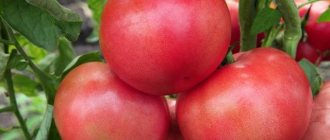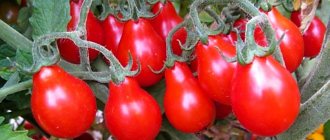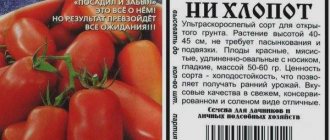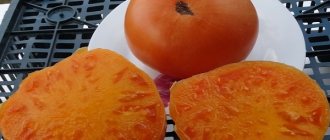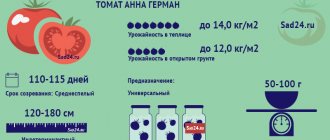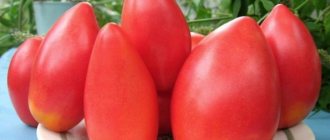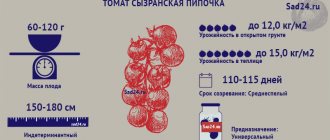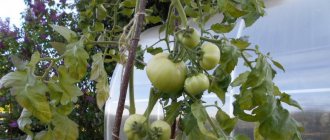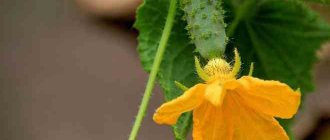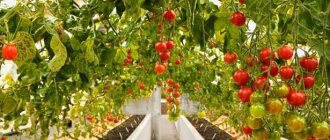The ideal variety means ideal yields and taste. This is all about the Russian Soul tomato, which has become the standard for domestic farmers. It is easy to grow, practically does not get sick, and is hardy and resistant to weather disasters.
| Height | Landing location | Ripening time | Fruit color | Fruit size | Origin | Fruit shape |
| Tall | Greenhouse, Open ground | Mid-early | Reds | Large | Variety | Flat-round |
Tomato Udachny - description and characteristics of the variety
Variety property
Having learned about the main features of the variety, even a student gardener will be able to successfully grow a large number of tasty tomatoes.
- Determinate bushes reach a height of 60 to 80 centimeters.
- Each cluster is tied with 7 to 9 fruits.
- The first tomatoes ripen 95-105 days after emergence.
- the fruits are round in shape;
- more than enough of each tomato reaches from 150 to 200 grams;
- red patina;
- the skin is dense;
- tomatoes have excellent taste characteristics;
- fruits are easily transported;
- the harvest is stored for 1-1.5 months.
That is, plant and care for the plant
Tomatoes of this variety are suitable for growing in open beds, as well as in film shelters. In the first part, seedlings are grown. To make the bushes stronger, it is advisable to extend the picking of the seedlings. This should be done after two true leaves have fully formed. Ten days before the planned transfer of seedlings to a permanent area, it is recommended to harden the seedlings. To do this, she needs to be dragged out into the open air for several hours. You can place containers on top of a balcony or veranda. Hardening will facilitate faster adaptation to transfer to a garden or greenhouse.
Like many other nightshade species, the Successful variety loves good light, for this reason it should be planted in places that are accessible to sunlight. It is better to provide protection from gusts of wind.
The bushes do not need shaping. Stepchildren can be deprived as needed. More than six bushes are planted on one square meter. As preventive measures against vegetable crops being damaged by diseases, it is necessary to periodically weed, loosen and hill up the planting beds. It is better to water the plant in the evening, using warm water.
Productivity, scope
According to reviews from experienced gardeners, it is possible to harvest up to 3.5 kilograms of ripe tomatoes from one bush. However, this is possible if you carry out all the necessary agrotechnical measures.
The scope of application for tomatoes of this variety is universal. Housewives successfully use them for canning valuable fruits, and in addition for preparing a variety of dishes. Sauces, pastes, and tomato juices are prepared from them. They are also suitable for fresh consumption, as well as in vegetable salads. Barrel pickles are incredibly tasty.
Disease resistance
Tomato variety Good has good resistance to diseases such as root and apical squabbles. To prevent the development of other diseases, preventive measures should be taken and the plant should be treated with special means.
Advantages and disadvantages of the variety
Many vegetable growers choose Udachny tomatoes every season, because they have many more positive qualities than negative ones.
As always, the advantages include the following:
- High yield.
- Resistance to the most common diseases.
- Absintheism is the need to form a bush.
- Tomatoes do not crack, have a long shelf life and are easily transported over long distances.
Of the disadvantages and inconveniences when growing, gardeners note only that in order to prevent pests and diseases, the plant must be periodically treated with special means.
Reflections of gardeners
For beginners, the opinions of experienced vegetable growers are very helpful in deciding whether the variety they like is worth planting on their plot or is shining by its absence. Tomatoes of the Udachny variety have mostly positive reviews. They are valued for their excellent taste, low maintenance requirements, and long shelf life.
Every garden owner has pet tomatoes. Those who have grown the Blestyaschiy variety are in most cases satisfied and recommend it to all their friends and acquaintances.
Description of the Russian Soul tomato and cultivation of the variety
The Russian Soul tomato belongs to the selection of agrobiologists from Siberia. The characteristics of the variety allow the plant to be cultivated in any region of the country. The fruits differ in shape, color, and taste.
Advantages of the variety
The Russian Soul tomato is included in the State Register of Breeding Achievements. The tomato has an average ripening period; it begins to bear fruit 100-105 days after germination.
The characteristics and description of the variety indicate the possibility of cultivation in the open ground of the southern regions and greenhouses. The tomato is unpretentious; various types of soil are suitable for the variety.
The height of the bush during the growing season reaches 140-180 cm. The plant requires tying to a support and removing excess shoots. To increase the yield of the crop, it is recommended to form a bush with 1-2 stems.
Reviews from vegetable growers indicate a variety of fruits, which can be flat, round and heart-shaped. At the ripe stage, tomatoes acquire an intense pink and red color. The yield of the variety is average (up to 6 kg per plant), the weight of the fruit is 250-300 g. The weight of tomatoes of the first harvest can reach 900 g.
The tomatoes are juicy, with fleshy pulp and a balanced sweet and sour taste. The dry matter content is 6-8%.
Tomatoes have a ribbed surface; when cut horizontally, 6-8 seed chambers are observed. In cooking, the fruits are used fresh for the preparation of sauces, juices, purees, and barrel pickling.
Tomatoes tolerate transportation well over distances. For this purpose, it is recommended to remove fruits at the stage of technical maturity. The description of the variety indicates the resistance of the crop to unfavorable growing conditions and temperature changes.
Agricultural technology for growing tomatoes
The plant is cultivated using the seedling method. Sowing seeds for seedlings is carried out 60-65 days before the expected date of planting in a permanent place. To do this, seeds are placed in containers with the prepared soil mixture to a depth of 1 cm.
Before planting, the seeds are treated with an aqueous solution of potassium permanganate and a growth stimulator. These activities are carried out with the aim of improving fruit set, improving plant health, and accelerating the germination process.
After watering with warm water using a sprayer, the container with planting material is covered with film until sprouts appear. In the phase of formation of 2 true leaves, picking is carried out in separate pots.
During the process of growing seedlings, it is necessary to observe the temperature regime. For normal development of seedlings, it is necessary to provide lighting and regularly monitor the level of soil and air humidity.
Seedlings in the phase of formation of 1 peduncle are transferred to a permanent place. The soil for the crop does not require special preparation. Compost or substrate is added to the prepared holes, watered and seedlings are planted.
It is recommended to place no more than 4 bushes per 1 m². Caring for the crop involves regular application of mineral and organic fertilizers. To stimulate the development of the root system, the bushes are hilled and the soil is periodically loosened.
The variety is not susceptible to diseases of nightshade crops. This is only possible if the rules of agricultural technology are violated. To prevent such problems, you should regularly ventilate the greenhouse and prevent the soil from drying out.
Among biological pests, the plant may be susceptible to melon aphids, against which special preparations are used. In open ground, a dangerous pest is the cutworm, which can actively develop in the presence of weeds.
To prevent their growth, mulch the soil using non-woven fiber. Using organic materials (straw, chopped grass, leaves) as mulch serves as a source of additional nutrition for plants.
Tomato variety “Russian Soul”: photos, videos, reviews, description, characteristics, yield
The tomato variety “Russian Soul” is a true representative of Siberian selection. Thanks to its characteristic features, the variety can be grown throughout Russia. The main advantages of the variety include unpretentiousness, good immunity and high taste characteristics.
Origin of the tomato variety “Russian Soul”
The tomato variety “Russian Soul” was developed by Siberian breeders in 1997. State registration was received in 1998. The originator is Vladimir Nikolaevich Dederko.
Description of the variety
Short review:
Fruit:
- Shape: round;
- Color: bright red, closer to scarlet;
- The skin is thick, glossy;
- The pulp is juicy, fleshy;
- The number of seed chambers is from 6 to 8;
- Dry matter content - 5-7%;
- Taste - balanced;
- Weight - from 350 to 600 grams.
Bushes:
- Indeterminate type, standard;
- Height varies from 1.4 to 1.6 meters;
- Leaves are medium sized, green in color;
- Inflorescence of intermediate type;
- The peduncle has an articulation.
Tomatoes: advantages and disadvantages
The “Russian Soul” variety has the following main advantages:
- Unpretentiousness to the influence of external conditions;
- Good tolerance to temperature fluctuations;
- High productivity;
- Immunity to major diseases;
- Excellent ripening;
- Possibility of transportation over long distances;
- High taste characteristics;
- Large fruit;
- Commercial appearance of the fruit.
Application of fruits
The fruits are not suitable for whole-fruit canning because they are quite large in size. However, they are perfect for barrel pickling. Fresh fruits will decorate any table. The high content of vitamins and balanced taste make tomatoes suitable for the production of healthy and tasty juice, as well as pastes and purees.
Growing tomatoes
The variety is recommended to be cultivated through seedlings.
How to prepare seeds?
Be sure to carry out pre-sowing treatment of seed material in a manganese solution and a growth stimulator. Thanks to these procedures, fruit set improves, plant immunity is strengthened, and the germination process is accelerated.
Sowing seed material
Description:
- Seeds are sown two months before the planned date of transplantation to a permanent location;
- Seed material is buried 1 cm in containers filled with nutrient substrate;
- Then pour warm water from a spray bottle and cover with cling film until the first shoots hatch;
- Picking into separate pots begins at the stage of a pair of well-developed leaves;
- Throughout the growth of seedlings, the required temperature regime is maintained. In order for seedlings to develop normally, they need additional lighting.
Rules for planting seedlings
Description:
- At the age of 60-65 days, the seedlings are ready for transplanting to a permanent place;
- Compost is added to the planting holes, the seedlings are watered and planted;
- An interval of 40 cm is maintained between the bushes, placing up to 4 plants per 1 m2.
Bush care
It is necessary to care for the variety according to the following scheme:
- Water generously with warm water in the evening;
- The bush must be tied up, and the branches are provided with reliable supports to prevent their possible breaking off under the ripening fruits;
- When grown in greenhouse conditions, the bush is grown with two stems, in open beds with three;
- The variety responds well to the application of both mineral complexes and organic fertilizers;
- Greenhouse structures are regularly ventilated;
- To stimulate the development of the root system, the bushes hill up and periodically loosen the soil;
- To prevent the growth of weeds, the soil is mulched with non-woven fabric. When using organic matter as a mulch layer (straw, chopped grass, leaves), it will become an additional source of nutrition for plants.
Diseases and pests
The “Russian soul” is not afraid of fungal diseases. The cause of the disease can only be improper care. To prevent this type of problem from occurring, regularly ventilate greenhouse structures and prevent the soil from drying out.
The most common pests:
- Melon aphid. The drug “Bison” is successfully used in pest control;
- Garden owl. Dangerous when grown in open beds. Timely removal of weeds will help prevent the appearance of the pest. In addition, the use of the drug “Zubr” is effective;
- Slugs. Their appearance is typical for the middle zone. They fight them by removing excess tops, as well as by isolating the soil, creating an unbearable environment for their habitat;
- Greenhouse whitefly. It mainly affects greenhouse structures. The drug “Confidor” is used against it.
Productivity
When good conditions are created, each plant produces 5-6 kg of fruit.
Which regions are best to grow in?
The variety “Russian Soul” shows the greatest yield in terms of yield in the southern regions and in the middle zone, when grown in open beds. The best regions are: Astrakhan, Crimea, Voronezh, Belgorod and Rostov-on-Don. In more northern regions, cultivation using film shelters and greenhouse structures is recommended.
Reviews about the variety from those who planted
Since its appearance, the popularity of the variety has been growing every year. Currently, tomato is on the list of favorite varieties of most gardeners.
The tomato variety “Russian Soul” is the standard for Russian farmers. It is unpretentious in care and cultivation, almost immune to diseases, quite hardy and resistant to weather vagaries.
2 hybrids for those who do not have a high greenhouse:
Tomatoes: advantages and disadvantages
The disadvantages of the variety include the occurrence of certain difficulties with gartering the stem and supporting the branches when grown by inexperienced gardeners. Also, tall greenhouse structures will be required for cultivation.
The “Russian Soul” variety has the following main advantages:
- Unpretentiousness to the influence of external conditions;
- Good tolerance to temperature fluctuations;
- High productivity;
- Immunity to major diseases;
- Excellent ripening;
- Possibility of transportation over long distances;
- High taste characteristics;
- Large fruit;
- Commercial appearance of the fruit.
Growing tomatoes
The variety is recommended to be cultivated through seedlings.
How to prepare seeds?
Be sure to carry out pre-sowing treatment of seed material in a manganese solution and a growth stimulator. Thanks to these procedures, fruit set improves, plant immunity is strengthened, and the germination process is accelerated.
Sowing seed material
Description:
- Seeds are sown two months before the planned date of transplantation to a permanent location;
- Seed material is buried 1 cm in containers filled with nutrient substrate;
- Then pour warm water from a spray bottle and cover with cling film until the first shoots hatch;
- Picking into separate pots begins at the stage of a pair of well-developed leaves;
- Throughout the growth of seedlings, the required temperature regime is maintained. In order for seedlings to develop normally, they need additional lighting.
You should also control the level of soil and air humidity.
Rules for planting seedlings
Description:
- At the age of 60-65 days, the seedlings are ready for transplanting to a permanent place;
- Compost is added to the planting holes, the seedlings are watered and planted;
- An interval of 40 cm is maintained between the bushes, placing up to 4 plants per 1 m2.
Features of cultivation and storage
The bushes are transplanted to a permanent location when they reach 55-60 days.
The optimal location is no more than 3-4 plants per 1 m2.
How to care:
- Leading in 2-3 shoots.
- Feeding 2-3 times a month.
- Watering 2-3 times a week.
- Mulching with a layer of 8-10 cm.
To fertilize the beds, bio-infusions from nettle, dandelion, and honey are used. Mullein solution has a good effect on growth. Minerals include phosphorus-potassium mixture and saltpeter.
Tomato "Marfa": description of the variety
| Variety name | Marfa |
| general description | Mid-season indeterminate hybrid |
| Originator | Holland |
| Ripening period | 95-105 days |
| Form | Flat-rounded with slight ribbing |
| Color | Red |
| Average weight of tomatoes | 130-140 grams |
| Application | Universal |
| Productivity of the variety | 6 kg per sq.m |
| Features of cultivation | Standard agricultural technology |
| Disease resistance | Resistant to most |
The variety was bred by Dutch breeders and zoned for all regions of Russia, including the Urals and Siberia.
It is preferable to grow in greenhouses and film shelters; in regions with a warm climate, planting in open ground is possible. Productivity is good, from 1 sq. m of planting, you can train up to 6 kg of selected tomatoes.
Marfa F1 is a mid-season, high-yielding hybrid of the first generation. The bush is indeterminate, tall, moderately spreading.
The volume of green mass is average, the leaves are medium-sized, simple, dark green. The root system is well developed. The fruits ripen in clusters of 6-8 pieces. In the fruiting phase, the bushes look very elegant. Ripening begins in mid-summer, the fruits can be harvested before frost.
You can compare the yield of this variety with others in the table below:
| Variety name | Productivity |
| Marfa | 6 kg per square meter |
| Lazy | 15 kg per square meter |
| Rocket | 6.5 kg per square meter |
| Summer resident | 4 kg per bush |
| Premier | 6-9 kg per square meter |
| Doll | 8-9 kg per square meter |
| Stolypin | 8-9 kg per square meter |
| Broody | 10-11 kg per square meter |
| Black bunch | 6 kg per bush |
| Fat Jack | 5-6 kg per bush |
| Brawler | 9 kg per bush |
General characteristics of the tomato Funtik f1 and description of the fruits of the hybrid variety
Many gardeners organize tomato yield competitions.
If a summer resident wants to surprise his neighbors, he should pay attention to the Funtik f1 tomato. These are large tomatoes that give a very good harvest
Their taste is simply excellent. Despite the fact that tomatoes are quite large, they have a universal purpose and are suitable for various uses. But still, Funtik tomatoes have gained the greatest popularity as an ingredient in salad. Their delicate sweet taste makes them an ideal addition to summer vegetable appetizers.
Funtik is a hybrid, so only original seeds purchased from the manufacturer should be used for cultivation. In this case, you can get ideal fruits with good weight and excellent taste. The Funtik variety was specially bred by Russian specialists. It has universal characteristics, so it is suitable for both open ground and greenhouses. The yield will be high in any case.
Description of the variety
This hybrid is classified as an indeterminate type. This suggests that the plant can have unlimited growth, so it should be pinched at the top. It is advisable to do this when the tomato reaches the 2 meter mark.
If you do not carry out the pinching procedure, the plant can stretch above 2.5 meters. In greenhouse conditions, the tomato can be even larger. But this has a bad effect on yield, since the tomato gives a lot of energy to the greens instead of saturating the fruits.
The plant grows very tall, but not too spreading, so the planting pattern for the bushes can be quite dense. You can place 6 tomatoes per 1 m².
Hybrid Funtik produces a large number of fruits. They are formed on brushes, of which there can be up to 12 pieces on each bush. There are 6 large tomatoes in one bunch.
The big advantage is that the plant produces all its fruits at once. This is convenient for those who grow tomatoes for canning. The productivity of the Funtik hybrid is very high. With proper agricultural technology, gardeners harvest up to 10 kg of delicious tomatoes from each bush.
The highest yield is observed with proper care of tomatoes. They must be well fertilized, weeded and moderately watered. As for spraying against diseases, it will not be superfluous for preventive purposes. But the manufacturer assures that this hybrid is highly resistant to late blight, verticillium and tobacco mosaic.
Fruit characteristics
The characteristics and description of the variety indicate that these tomatoes have a universal purpose and can be suitable for any type of use.
The tomatoes turn out quite large. Their average weight is 230 g. The color of the fruit is red, and the taste is sweet and very pleasant. Large tomatoes are not very convenient to preserve as a whole, but Funtik fruits are quite suitable for juice, sauce or tomato paste. In addition, they are considered an excellent addition to summer vegetable salad.
The fruits of this variety have a fairly dense skin, so they can be easily transported even over long distances without the risk of losing their presentation. Moreover, tomatoes are stored in a cool place for a very long time. If you harvest in August, you can enjoy the pleasant taste of fresh tomatoes until mid-autumn.
Reviews about the Funtik tomato are extremely positive.
Veronica, Shakhty: “Excellent tomato, I have never seen such a productive tomato. To the envy of all my neighbors, I collected 10-12 kg per bush! The fruits are very tasty, aromatic, fleshy and elastic. Do not crack during ripening and storage. They can lie there for a long time!”
Marina, Moscow region: “I grew it in a greenhouse. The bushes were not sick, the yield was as stated by the manufacturer. I used tomatoes mainly for pasta and salads. In general, it was not possible to preserve it; the fruits grew too large!”
Description of the tomato variety It grows itself, its characteristics and yield
Fans of growing vegetables are looking for suitable varieties so that their care is not too demanding. One of these is considered to be the tomato that grows itself. Valued for its good taste and ease of care. It takes its rightful place among the best tomato varieties.
Description
Gardeners who grow vegetables pay attention to the description of the variety when purchasing seeds. It should grow and develop well in a city with characteristic climatic features
It grows on its own - exactly what you need. Suitable for growing in any climate zone.
Agricultural technology
It grows itself - a tomato that was bred to sow seeds directly into the soil. In this case, the earth should warm up to a temperature of at least +15 °C. At the beginning of March, seeds are planted in seedling containers. When planting sprouts in open soil or sowing seeds, you must adhere to the 30x50 cm pattern.
Green mass
The plant is considered low-growing, as it reaches a height of no more than 45 cm. On average, the length of the lashes varies from 30 to 40 cm. The bushes do not require shaping by humans. The foliage is medium, the leaves have a rich green color.
Fruit
The shape of the fruit is flat-round. The pulp is rich red. The weight of one tomato varies from 60 to 110 g. The bushes produce a good harvest. The taste of tomatoes has a characteristic tomato sourness.
Tomatoes taste different from store bought ones. Suitable for preparing fresh salads and hot dishes. They can be used during canning. Moreover, they roll up tomatoes separately from other vegetables or make assorted colors. Samo grows is also used for pickling.
Some fruits resemble cherry tomatoes, as their weight is less than 60 g. They are suitable for preparing snacks and decorating main dishes.
Advantages and disadvantages
The tomato variety Grows itself has the following advantages:
- early ripening of the crop, quick return from the bushes;
- there is no need to form stems;
- characteristic tomato taste with a sour note.
Ripe tomatoes can be transported over long distances. They are stored for a long time and deteriorate slowly. Low growing bushes make harvesting easy. The tomato variety itself grows has an immune system that can protect against any disease. Bushes are rarely affected by pests.
The variety has another advantage - the ability to plant on a balcony or loggia. Due to its compactness, caring for a tomato does not create additional problems, especially if the bush is grown in containers with soil on the balcony.
Among the disadvantages is the thin skin, which is not able to prevent cracking of tomatoes. In general, the characteristics of the vegetable are satisfactory for gardeners, which makes it a favorite on plots of land. It grows on its own and does not require careful care. All that is required of a person is timely watering in the initial stages of growth and removal of weeds from the beds. If you adhere to this, tomato bushes will delight you with ripe, juicy and tasty fruits.
Description and characteristics of the variety
Tomato Russian Soul is an indeterminate tall variety. The bushes are strong and powerful, among the main characteristics:
- shoot height in greenhouses up to 1.8 m, in open areas up to 1.6 m;
- stems are moderately leafy and semi-spreading;
- 6-8 tomatoes are tied on fruiting clusters.
What are the signs of fruits:
- average weight 350-500 g;
- large tomatoes 800-900 g;
- bright scarlet color;
- seed nests 6-8;
- dry matter level 5-7%;
- the skin is durable.
Country of origin and year of registration
Russian soul is a convenient variety for all climatic zones of the country. Designed for indoor and outdoor areas. Created in Russia by Siberian breeders in 1997. Entered into the State Register immediately - in 1998.
Which regions are best to grow in?
Tomato is successfully grown throughout the country:
- in the northern regions in heated glass greenhouses;
- in the temperate zone in greenhouses with subsequent opening;
- in Crimea, Krasnodar, Sochi, planting is carried out in unprotected beds.
Method of use
The variety is good in any form. Can be used universally for:
- fresh cuts and salads;
- assorted and hot dishes;
- pickling and marinating in slices;
- juices, sauces, dressings, pastes.
Growing a variety on a personal plot
Tomato Russian Soul is an indeterminate tall variety. The bushes are strong and powerful, among the main characteristics:
- shoot height in greenhouses up to 1.8 m, in open areas up to 1.6 m;
- stems are moderately leafy and semi-spreading;
- 6-8 tomatoes are tied on fruiting clusters.
The ripening period is mid-early - 98-110 days from germination.
What are the signs of fruits:
- average weight 350-500 g;
- large tomatoes 800-900 g;
- bright scarlet color;
- seed nests 6-8;
- dry matter level 5-7%;
- the skin is durable.
The taste harmoniously combines sourness and sweetness, is rich and tender.
Russian soul is a convenient variety for all climatic zones of the country. Designed for indoor and outdoor areas. Created in Russia by Siberian breeders in 1997. Entered into the State Register immediately - in 1998.
Tomato is successfully grown throughout the country:
- in the northern regions in heated glass greenhouses;
- in the temperate zone in greenhouses with subsequent opening;
- in Crimea, Krasnodar, Sochi, planting is carried out in unprotected beds.
Method of use
The variety is good in any form. Can be used universally for:
- fresh cuts and salads;
- assorted and hot dishes;
- pickling and marinating in slices;
- juices, sauces, dressings, pastes.
The bushes are transplanted to a permanent location when they reach 55-60 days.
The optimal location is no more than 3-4 plants per 1 m2.
- Leading in 2-3 shoots.
- Feeding 2-3 times a month.
- Watering 2-3 times a week.
- Mulching with a layer of 8-10 cm.
To fertilize the beds, bio-infusions from nettle, dandelion, and honey are used. Mullein solution has a good effect on growth. Minerals include phosphorus-potassium mixture and saltpeter.
After obtaining seedlings from seeds using well-known methods, they are transferred to permanent soil in a greenhouse. The sprouts should be 55-60 days old. No more than 3-4 stems can be planted per 1 m² of bed. To obtain a high yield, you need to water the bushes in time with cool water, loosen the soil under them, and destroy weeds.
We invite you to familiarize yourself with: Cucumber Phoenix 640: reviews, description of the variety, photos
Watering should be plentiful. It is made after sunset. If a gardener grows tomatoes in a greenhouse, then the room must be regularly ventilated.
The soul of Siberia is practically not infected with fungal diseases, but fungi can cause significant damage to plants if the farmer does not properly care for the tomato. In order to avoid crop losses, it is necessary to maintain soil moisture in the greenhouse that is comfortable for plants. To combat viral infections, appropriate drugs are used.
Dangerous garden pests for the described tomato are considered to be garden cutworms and melon aphids. If a farmer finds signs of these pests, then to destroy them, it is recommended to use appropriate chemicals that destroy these insects. Melon aphids are destroyed with the preparation “Zubr”, and whiteflies are eliminated with the preparation “Confidor”.
Slugs cause enormous damage to tomatoes. To get rid of this pest, you need to remove excess leaves from the bushes and treat the soil under them with ash flour.
Tomato Soul of Siberia characteristics and description of the variety, productivity with photos
Fruit characteristics
The versatile berry is grown in greenhouses and open ground, depending on climatic conditions. Plant characteristics:
- mid-season, ripening period up to 105 days;
- plant height can reach 1.8 m;
- the bush has two stems in greenhouse conditions and three in open ground;
- indeterminate;
- unpretentiousness, various soils and climatic conditions are suitable for the variety;
- resistant to fungal diseases;
- average yield, up to 6 kg per bush per season;
- good transportability; for this purpose it is recommended to pick unripe tomatoes.
The Russian Soul tomato variety shows the highest yields in: Rostov-on-Don, Belgorod, Crimea, Astrakhan.
The fruits of the variety differ:
- flat-round or heart-shaped;
- bright red or red-pink;
- large in size, the weight of the first collection can reach 900 grams;
- juiciness;
- fleshiness;
- ribbing;
- sweet with sourness.
The Russian Soul tomato is a mid-early variety; 100-105 days pass from planting seedlings in the ground to ripening the fruits. The bush is indeterminate, standard, quite tall 140-160 cm, in the southern regions it can reach 170-180 cm. It produces good yields both in unprotected soil and in greenhouse shelters.
It has very high resistance to diseases. Fully ripe fruits are bright red, even scarlet. The tomatoes are meaty and have a balanced taste. They are round in shape. The tomatoes are very large, from 350-600 grams, and at the first harvest they can reach 700-850. Number of nests 6-8, dry matter content 5-7%. The harvested crop tolerates transportation well and ripens if the fruits are collected slightly unripe.
The tomato variety Russian Soul was obtained in Russia by breeding specialists from Siberia in 1997. It received state registration as a variety for open ground and greenhouse shelters in 1998. Almost immediately it became popular among lovers of large-fruited tomatoes and still deservedly takes its place among the list of favorite varieties.
The best yield results are shown in the south and in the middle zone, in open ground. The best regions for cultivation are Astrakhan, Crimea, Voronezh, Belgorod and Rostov-on-Don. In more northern regions it is grown under film covers or in greenhouses.
Even the smallest fruits of the “Russian Soul” variety are not suitable for whole-fruit canning. These tomatoes are very good when pickled in barrels. When fresh, they will serve as a real decoration for any table. Due to the high content of vitamins and balanced taste, they make a very healthy and tasty juice. Pastes and purees are also very good.
The fruits are aromatic and sweet, fleshy, with a smooth surface. Without a white core inside and a yellow spot at the stalk, without a seed inside. Seedlings are planted at a density of 3–4 stems per 1 m², on days 50–55. Plants need staking, removal of stepsons and formation into a single stem.
Based on reviews of the Soul of Siberia tomato, the variety is productive, the rounded fruits are distinguished by a balanced and pronounced taste. The collected fruits tolerate transportation well and ripen if collected unripe.
Tomatoes of the Dusha Siberia variety require mandatory staking. To increase productivity, it is important to install special stem supports.
Tomato Dome of Russia characteristics and description of the variety
- 1 Tomato variety suitable for all of Russia - description of the hybrid tomato “Red Dome”
- 2 Description, characteristics, sowing seedlings, fertilizing, yield, photos, videos and the most common diseases of tomatoes of the “Russian Domes” variety
- 3 Tomato “Golden Domes”: characteristics and description of the variety, photo, yield, planting and care
- 4 Tomato golden domes: reviews, photos of bushes and the resulting harvest, instructions and growing tips from experienced summer residents
“Red Dome” was bred by Russian breeders. In the state register of tomatoes, an entry about this hybrid was made in 2014. Growing area.
Tomato "Red Dome": description of the variety
“Red Dome” is an F1 hybrid that has absorbed all the best characteristics of the varieties.
The tomatoes are determinate, not standard, early ripening - about 90 days, have a normal root system and a powerful stem up to 70 cm in height. Resistant to many diseases.
Suitable for both open ground due to its low growth, and for greenhouses.
The productivity of tomatoes is high, for the entire season up to 17 kg/m2, about 3 kg per plant.
"Red Dome" has the following advantages:
- large fruits;
- high productivity;
- rich taste;
- long storage;
- does not deteriorate when carried;
- resistant to diseases.
Defects are rarely identified in hybrids, as the best qualities are selected.
Fetal characteristics
- The fruit is large, with a pointed tip - dome-shaped.
- Fleshy, dense tomatoes will be stored for a long time.
- The color of an unripe fruit is pale green, while a ripe fruit is dark red.
- They have many cameras;
- dry matter content is high.
- The average weight of a Red Dome tomato is 150-200 g.
Note: It tolerates transportation well due to its structure.
Red Dome tomatoes are large, do not crack, and have thick skin. They contain quite a lot of vitamins compared to some representatives of tomatoes.
Suitable for consumption raw, salad, excellent taste, moderately sweet. Tolerates preservation well. Due to the high dry matter content and density of the fruit, it is not suitable for juice production.
List of tomato varieties presented on our website, which are also recommended for pickling: Kibits, Lapwing, Fat Bosun, Sugar Plums, Chocolate, Yellow Pear, Goldfish, Pink Impression, Argonaut, Lyana Rozovaya, Miracle of the Market
Recommendations for cultivation
Cultivation is available throughout Russia.
Seedlings are planted in mid-March, having previously been disinfected and soaked. Upon reaching 50 days, they can be planted in open ground; they are transplanted into a heated greenhouse in April; if there is no heating in the greenhouse, they are planted in May.
The planting pattern is checkerboard or double-row, the distance between rows is 40 cm, between plants is 70 cm.
Water at the root with plenty of water, not often. Fertilizing is carried out according to the usual schedule - up to 5 times every 10 days with mineral fertilizers.
Requires pinching up to the first hand. Possible tying due to the abundance of heavy fruits. Loosening is preferred.
Important: It is permissible to grow even in cold regions, due to its short stature.
Characteristics of the hybrid “Red red F1”
The hybrid called “Red Red F1” was developed quite recently, so you can’t find too much information about it. But his characterization is more than attractive. The growth of the bush is quite high - up to 150 cm, branching is average. At the same time, the bush itself looks quite powerful due to its single strong stem. Clusters with large fruits of 5-7 pieces are formed on it.
The weight of one tomato can vary from 200 to 500 g. You can plant 3 bushes per square meter. The good news is that one plant can produce up to 8 kg of fruit.
The pulp of Red Red F1 tomatoes is sweet, loose, and sugary in taste. The tomatoes themselves are round, even, smooth and dense. They sing early enough. Since the fruits are quite large, it is difficult to preserve them whole or in halves. But they are wonderful fresh, in salads and when served in the form of lecho, adjika, or tomato sauce.
Attention! Another excellent advantage of this hybrid is its resistance to fungal diseases and sudden temperature changes.
Rules for growing seedlings
You need to buy seed material for growing the hybrid “Red red F1” very carefully. You should carefully consider the packaging, which indicates compliance with international standards and GOST No. 12260-81. You need to grow seedlings according to certain rules:
Tomato seeds Red red F1
- This hybrid form is sown in early or mid-March, waiting until the waxing moon stage.
- You can buy a mixture of soil for planting, or you can prepare it yourself. To do this, you need to take some fertile soil and disinfect it by calcination or using special preparations.
- The prepared soil should be placed in special boxes or containers, which can also be purchased at a garden store.
- The seed must be immersed in a weak pink solution of potassium permanganate for 30 minutes. After this, the seeds are washed with tap water and dried well.
- Seeds should be placed 1 cm deep in prepared soil.
- Until the first shoots appear, the box with seeds should stand in a warm place with slight shade.
- As soon as the first shoots appear, the box should be moved to a place with good sunlight, for example, on a wide window sill on the south side.
- When the sprouts have 3 leaves, each plant needs to be planted in separate pots - pricked.
- After diving, tomatoes need to be watered more often so that the soil under them does not dry out.
- 10-14 days before planting in the garden, you need to start hardening the seedlings at a suitable temperature.
Attention! There is no point in collecting seeds yourself from the harvest, since the fruits you get will be completely different. Therefore, seed material should be purchased only in specialized stores.
Planting and caring for “Red Krasno F1”
The seedlings of this hybrid are transferred to an open garden bed only when the outside temperature stabilizes. There should be no threat of late frosts in the spring. If you are still afraid of a sharp drop in temperature, it is worth covering the bed with sprouts with a thick transparent film for a certain period of time.
“Red Red F1” seedlings should be planted in open ground in the evening or during the day, but in cloudy weather. It is strictly not recommended to do this in bright sunshine. When planting, the recommended distance between plants should be at least half a meter, but between rows - 0.8 - 1 m. The bed with young tomatoes should be well watered and a little shade should be created.
Tomato bush Red red F1
Also, gardeners who want to grow this hybrid in their garden need to take into account some features in caring for it:
- During flowering and fruiting, Red Red F1 tomatoes need to be watered abundantly;
- the hybrid needs to be fed regularly, for which compost is used;
- when the hybrid blooms, its bush needs to be lightly shaken periodically;
- when growing tomatoes, you can use special growth regulators, they will allow you to get the harvest faster, but even without them the hybrid will grow quite well;
- you need to be very careful with nitrogen fertilizer;
- You should pay close attention to the formation of the bush; you should remove the stepchildren in a timely manner.
The hybrid “Red red f1” can be grown both in the open air and in a greenhouse. If the gardener chooses the second option, the greenhouse should be ventilated every day.
Advice. The land after this hybrid is best used for cabbage or cucumbers, but not for potatoes.
Planting material for this hybrid is quite expensive. A package of 6 seeds can cost 60-100 rubles. But the taste of the fruit “Red red f1” will fully justify the costs.
Features of planting “Red Red” tomatoes in a greenhouse
Planting and subsequent cultivation must be done with a minimum density. There should not be more than three bushes per 1 m² of greenhouse. In this case, the distance between the bushes should be about 50-80 cm, and between the rows - 80-100 cm.
Planting seedlings depends on its condition and the climatic characteristics of the area. On average, seedlings begin to be transplanted in the interval from late April to early June.
It is better to grow tomatoes of this variety entirely in a greenhouse. The best option is to plant seedlings in a greenhouse located in a greenhouse, followed by cultivation after pinching has been carried out.
In this case, it will be possible to obtain the highest possible yields.
If it is not possible to grow seedlings in a greenhouse, then it is best to place them in peat pots. This way the roots of the plant are less damaged.
Sowing seeds
In greenhouses equipped with a heating system, reviews recommend planting the Red Red F1 tomato with seeds as early as the end of March. When growing in film greenhouses, you need to prepare seedlings in advance.
Selection of seed material
The timing of sowing seeds of the Red Red variety for seedlings depends on the climatic conditions of the region. Seedlings of the hybrid variety will be ready for transplanting into greenhouse beds in about 2 months, and the soil in the greenhouse should already be warmed up to +10 by this time. Since seedlings of the F1 variety will quickly begin to stretch, you should not overexpose them in a box - this will affect the yield of tomato bushes.
Source: https://sad1111.com/tomat-kupola-rossii-harakteristika-i-opisanie-sorta/
Tomato Russian soul
photo author Nadezhda Neklyudova
Mid-season, indeterminate, large-fruited tomato variety. Recommended for growing in greenhouses and in the southern regions in open ground.
The height of the bush is up to 1.7 meters in a greenhouse and 1-1.2 m in a greenhouse. Requires tying to the support and pinning. We recommend forming the plant into 1-2 stems.
Basic qualities of fruits
photo author Olesya Novoselova
The fruits can be (according to gardeners) flat-round and heart-shaped, pink-red in color at maturity, weighing 250-300 grams, fleshy, tasty (slightly sour). These tomatoes are good for fresh consumption, as well as for making juices and sauces.
The yield of the variety is average.
We recommend sowing the seeds of this tomato variety for seedlings 60-65 days before the intended planting in the ground.
If you grew Russian Soul tomatoes, write whether you liked them or not. What shape were the fruits? If possible, attach to the comment a photo of the entire bush as a whole or individual fruits that you grew. Thank you.
Your reviews of the Russian Soul tomato and additions to the description will help many gardeners evaluate this variety objectively and decide whether it is worth planting or not.
Website about the dacha
Description and characteristics of the Fighter tomato variety, reviews, photos
The second name of this tomato is Buyan .
An early, low-growing, determinate tomato variety. Recommended for open ground and film shelters.
A bush up to 50 cm high, which does not require pinching. The leaf is medium sized, dark green, highly corrugated. The inflorescence is simple. The first inflorescence is laid above the 6-7 leaf, the subsequent ones - after 1-2 leaves. A very unpretentious variety, resistant to cold weather and drought.
Basic qualities of fruits
The fruits are cylindrical cream, glossy, smooth, red in color at maturity, weighing about 70 grams (the first ones may be slightly larger). The taste is good. These tomatoes are universally used - good for fresh consumption, as well as for pickling and drying.
Advantages of the variety : resistance to bacterial diseases and tobacco mosaic virus, early ripening, versatility of use, drought resistance.
Originator : Siberian Research Institute of Plant Growing and Breeding of the Russian Agricultural Academy.
Yield of tomato Fighter : up to 2.5 kg of fruit from 1 plant (subject to agricultural practices).
The tomato variety Fighter is included in the State Register of the Russian Federation for garden plots, household plots and small farms for cultivation in open ground and under film covers.
Features of growing tomatoes Fighter, planting and care
We recommend sowing seeds for seedlings 50-55 days before the intended planting in the ground. Seedlings dive at the stage of two true leaves. When planting seedlings in a permanent place per 1 sq. It is recommended to place up to 6 plants per meter of plot. Planting pattern : 70 x 30 - 40 cm.
Further care for tomatoes consists of timely watering, fertilizing with complex mineral fertilizer, pinching and preventive measures to protect against diseases and pests.
Tomato Fighter on video
If you grew Boets (Buyan) tomatoes, please write whether you liked them or not. What was the yield and taste of the fruits like under your climatic conditions? How do you rate the disease resistance of this variety? Briefly describe the advantages and disadvantages of this tomato in your opinion, evaluate the taste of the variety. If possible, attach a photo of the fruits you grew to your comment. Thank you!
Your reviews of the Fighter tomato and additions to the description will help many gardeners evaluate this variety more objectively and decide whether it is worth planting or not.
Best reviews from our readers
First time planting. We grew up on the street. I was very pleased. Incredibly abundant, even, uniformly sized fruits. I didn’t tie it up, the bushes lay directly on the ground on straw mulch, but not a single bush became infected with late blight. For example, Chanterelle got sick all under the same conditions as Fighter. Sweeter than, for example, Sanka. Definitely plant!
I have been planting this variety for a long time and much earlier than written in your article. Probably 15 years, that's for sure. A very good variety for open ground. I also tried it in a greenhouse, but in open ground it is tastier and sweeter. Productive, unpretentious. For those who don’t have a greenhouse, this is ideal in our weather conditions.
For several years I have been planting in open ground, but under cover, because the dacha is in the taiga. They do not outgrow the stated height, are tasty, productive, and easy to eat and salt. I recommend
The most favorite variety. Very short, no more than 50 cm even in a greenhouse. The seedlings did not stretch out like the rest. I planted seedlings in early March and planted them in the greenhouse at the end of May, around the 20th. They withstood the frost well in the greenhouse. By the end of June there were already large tomatoes, in some places they were even turning red. I harvested 3 times from the whole bush, it bears fruit all summer until September. The taste is excellent. Photo for June 20. I only tied it to a peg once, because the tomatoes caused the bush to fall to the ground. I didn’t cut the stepsons.
I really liked the taste and yield, good for pickling. sang on the bush, but our summer was not enough, most of the harvest did not have time to ripen. the green ones sang until November
I live not far from you, 250 km in a village. We plant a tomato variety Buyan. If you don’t plant this variety, there are a lot of small ones. I am a stepson, on average I get 2600 grams per bush. We water depending on the weather. After planting, I do the first watering after 1.5-2 weeks. and then I water the tomatoes once throughout the summer. in 2021, on September 25, I picked the last tomatoes. Over the entire summer, half a bucket of tomatoes were missing, and I harvested more than 100 buckets. excellent variety
Very good variety. It froze at the beginning of June. I thought I was dead. And it came from the root from under the mulch! And it ripened on the vine! This is with terrible heat and drought in the summer and constant rain and coolness in the first half of September. The harvest under these conditions turned out to be very good. And I didn't get sick.
And I liked the tomato. The bushes are compact, not overgrown, there are a lot of tomatoes. The taste is sweet, without sourness. The weight of an average tomato is about 120 grams. Good for salads and look beautiful when preserved. I think the harvest would be greater with regular care. Now it’s September, the bushes are in bloom and full of small tomatoes. I'll definitely plant more.
I grew them in open ground. The bushes were not high, as stated by the manufacturer, about 50 cm. The bushes were not pinched. But the harvest was not special. Maybe this summer was like that. Because almost all varieties did not please with the harvest. They taste no different in sweetness, like all early ones. I won’t draw conclusions based on one year. I will plant it again this year.
TomatLand 30,829 comments
You can buy “Fighter” tomato seeds from the seller
Description of the tomato variety Soul of Siberia, its characteristics and yield
Tomato Soul of Siberia f1 is a mid-early hybrid, tall, intended for planting and growing in open ground or greenhouses. The variety is resistant to diseases, the fruits do not crack and are even in size and shape.
Description of the variety
The fruits are aromatic and sweet, fleshy, with a smooth surface. Without a white core inside and a yellow spot at the stalk, without a seed inside. Seedlings are planted at a density of 3–4 stems per 1 m², on days 50–55. Plants need staking, removal of stepsons and formation into a single stem.
Based on reviews of the Soul of Siberia tomato, the variety is productive, the rounded fruits are distinguished by a balanced and pronounced taste. The collected fruits tolerate transportation well and ripen if collected unripe.
Tomatoes of the Dusha Siberia variety require mandatory staking. To increase productivity, it is important to install special stem supports.
Main characteristics
The Siberian region is famous for its fertile lands, which makes it possible to obtain the best varieties of tomatoes. The description of the variety consists of the following indicators:
- height - more than 180 cm;
- fruit size - up to 900 g;
- ripening time is 85–90 days;
- sweetish taste;
- pink color of heart-shaped fruits;
- universal growing method.
Some tomatoes reach sizes of 500–600 g, the first harvest can have fruits of 700–850 g. A bush with 2 stems in greenhouse conditions and 3 in open ground. The stems have 6–8 nests, the dry matter content is 5–7%. Productivity
Under favorable conditions, one bush produces 5–6 kg of harvest. On average, you get 20–25 kg of fruit per 1 m² - this is a good indicator.
Advantages and disadvantages of the variety
Tomatoes of this type have the following advantages:
- unpretentiousness to weather conditions;
- resistance to temperature changes;
- high yield;
- good resistance to diseases.
Tomatoes grow well in any type of soil and tolerate fertilizers of both natural and artificial origin.
Among the disadvantages, they note the need for high greenhouses and the presence of experience in tying up the trunk and supporting the branches.
Growing in greenhouse conditions allows harvesting throughout the year. This is especially true for Siberia, where summer is quite short.
Diseases and pests
A unique characteristic of the variety is that the fruits are not susceptible to fungal diseases. The presence of a disease may indicate extremely poor and inappropriate care.
To avoid problems when cultivating the variety, it is important to maintain soil moisture and ventilate the room in which the plants are located. Significant temperature changes will not harm tomatoes, but you should still be careful
Harmful insects can harm the growth and yield of the variety, for example, melon aphids or cutworms. In these cases, appropriate medications are used, following the instructions on the package
It is also important to constantly remove weeds on which pests can develop.
Slugs can cause considerable damage to bushes. They are dealt with by zoning the soil and removing excess tops.
In greenhouses, most often there is an invasion of melon aphids, against which the use of the drug “Zubr” is effective, and greenhouse whitefly, which can be controlled using the drug “Confidor”.
Rules of care
Care consists of fertilizing, watering and loosening the soil. It is important to water abundantly in the evening with cool water. If the plant is in greenhouse conditions, the room should be regularly ventilated.
Technical data of the plant
The characteristics and description of the variety Soul of Siberia are as follows:
- The growing season of a tomato from seedlings to the first fruits lasts 85-90 days.
- The bush of the plant can stretch to a height of 1.8 m, and sometimes higher. From 6 to 8 ovaries develop on the stems.
- The average fruit weight is 0.5-0.6 kg, but the first harvest can produce specimens weighing from 0.7 to 0.9 kg. They are shaped like a heart, painted pink. Tomatoes taste sweet.
- For plants of the described variety, it is necessary to use a garter on strong supports. The formation of bushes has its own characteristics. It is produced in 2 stems if the tomato is grown in a greenhouse. When growing a plant in open ground, 3 stems are used to form bushes.
Reviews from gardeners about the Soul of Siberia tomatoes show that with timely implementation of all necessary agrotechnical procedures, each bush can produce from 5 to 6 kg of fruit. From every 1 m² of bed, many farmers receive 20-25 large (700-800 g) fruits.
We suggest you read: Beetroot for type 2 and type 1 diabetes: is it possible to eat boiled and raw red beets, benefits for gestational diabetes in pregnant women
According to the observations of farmers, the Soul of Siberia is unpretentious to weather conditions and can withstand sudden temperature changes. The tomato variety described grows well in almost any type of soil. Plants can be fed with any organic or mineral fertilizers.
Gardeners note such a disadvantage when growing this tomato on farms as the need for a high greenhouse. A vegetable grower must be able to properly tie up plant trunks and place supports under the branches. Breeders recommend that Siberian farmers grow this tomato in greenhouse blocks, as this will allow them to harvest almost all year round.
